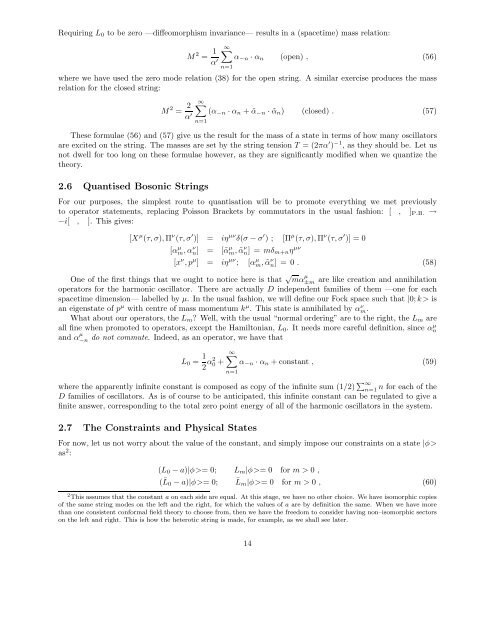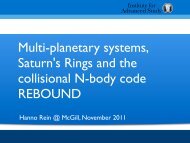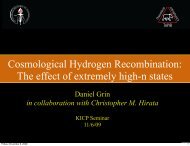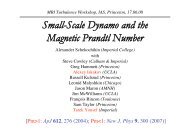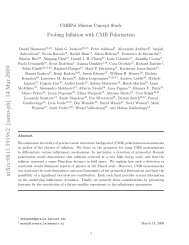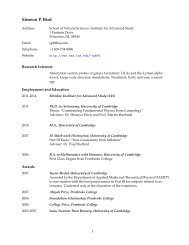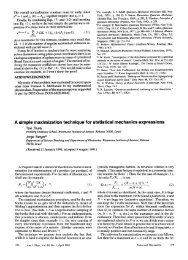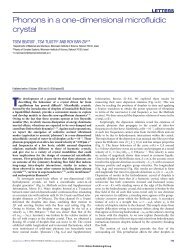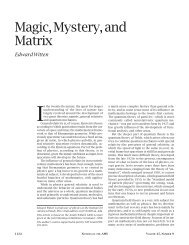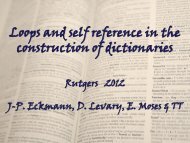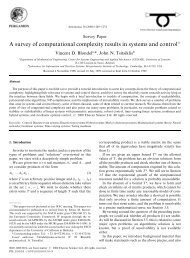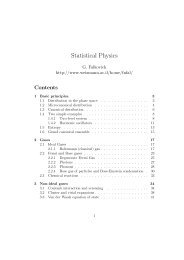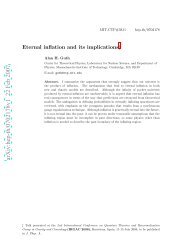Introduction to String Theory and D–Branes - School of Natural ...
Introduction to String Theory and D–Branes - School of Natural ...
Introduction to String Theory and D–Branes - School of Natural ...
Create successful ePaper yourself
Turn your PDF publications into a flip-book with our unique Google optimized e-Paper software.
Requiring L0 <strong>to</strong> be zero —diffeomorphism invariance— results in a (spacetime) mass relation:<br />
M 2 = 1<br />
α ′<br />
∞<br />
α−n · αn (open) , (56)<br />
n=1<br />
where we have used the zero mode relation (38) for the open string. A similar exercise produces the mass<br />
relation for the closed string:<br />
M 2 = 2<br />
α ′<br />
∞<br />
(α−n · αn + ˜α−n · ˜αn) (closed) . (57)<br />
n=1<br />
These formulae (56) <strong>and</strong> (57) give us the result for the mass <strong>of</strong> a state in terms <strong>of</strong> how many oscilla<strong>to</strong>rs<br />
are excited on the string. The masses are set by the string tension T = (2πα ′ ) −1 , as they should be. Let us<br />
not dwell for <strong>to</strong>o long on these formulae however, as they are significantly modified when we quantize the<br />
theory.<br />
2.6 Quantised Bosonic <strong>String</strong>s<br />
For our purposes, the simplest route <strong>to</strong> quantisation will be <strong>to</strong> promote everything we met previously<br />
<strong>to</strong> opera<strong>to</strong>r statements, replacing Poisson Brackets by commuta<strong>to</strong>rs in the usual fashion: [ , ]P.B. →<br />
−i[ , ]. This gives:<br />
[X µ (τ, σ), Π ν (τ, σ ′ )] = iη µν δ(σ − σ ′ ) ; [Π µ (τ, σ), Π ν (τ, σ ′ )] = 0<br />
[α µ m, α ν n] = [˜α µ m, ˜α ν n] = mδm+nη µν<br />
[x ν , p µ ] = iη µν ; [α µ m , ˜αν n ] = 0 . (58)<br />
One <strong>of</strong> the first things that we ought <strong>to</strong> notice here is that √ mα µ<br />
±m are like creation <strong>and</strong> annihilation<br />
opera<strong>to</strong>rs for the harmonic oscilla<strong>to</strong>r. There are actually D independent families <strong>of</strong> them —one for each<br />
spacetime dimension— labelled by µ. In the usual fashion, we will define our Fock space such that |0; k> is<br />
an eigenstate <strong>of</strong> p µ with centre <strong>of</strong> mass momentum k µ . This state is annihilated by α ν m.<br />
What about our opera<strong>to</strong>rs, the Lm? Well, with the usual “normal ordering” are <strong>to</strong> the right, the Lm are<br />
all fine when promoted <strong>to</strong> opera<strong>to</strong>rs, except the Hamil<strong>to</strong>nian, L0. It needs more careful definition, since α µ n<br />
<strong>and</strong> α µ<br />
−n<br />
do not commute. Indeed, as an opera<strong>to</strong>r, we have that<br />
L0 = 1<br />
2 α2 0 +<br />
∞<br />
α−n · αn + constant , (59)<br />
n=1<br />
where the apparently infinite constant is composed as copy <strong>of</strong> the infinite sum (1/2) ∞ n=1 n for each <strong>of</strong> the<br />
D families <strong>of</strong> oscilla<strong>to</strong>rs. As is <strong>of</strong> course <strong>to</strong> be anticipated, this infinite constant can be regulated <strong>to</strong> give a<br />
finite answer, corresponding <strong>to</strong> the <strong>to</strong>tal zero point energy <strong>of</strong> all <strong>of</strong> the harmonic oscilla<strong>to</strong>rs in the system.<br />
2.7 The Constraints <strong>and</strong> Physical States<br />
For now, let us not worry about the value <strong>of</strong> the constant, <strong>and</strong> simply impose our constraints on a state |φ><br />
as 2 :<br />
(L0 − a)|φ>= 0; Lm|φ>= 0 for m > 0 ,<br />
( ¯ L0 − a)|φ>= 0; ¯ Lm|φ>= 0 for m > 0 , (60)<br />
2 This assumes that the constant a on each side are equal. At this stage, we have no other choice. We have isomorphic copies<br />
<strong>of</strong> the same string modes on the left <strong>and</strong> the right, for which the values <strong>of</strong> a are by definition the same. When we have more<br />
than one consistent conformal field theory <strong>to</strong> choose from, then we have the freedom <strong>to</strong> consider having non–isomorphic sec<strong>to</strong>rs<br />
on the left <strong>and</strong> right. This is how the heterotic string is made, for example, as we shall see later.<br />
14


